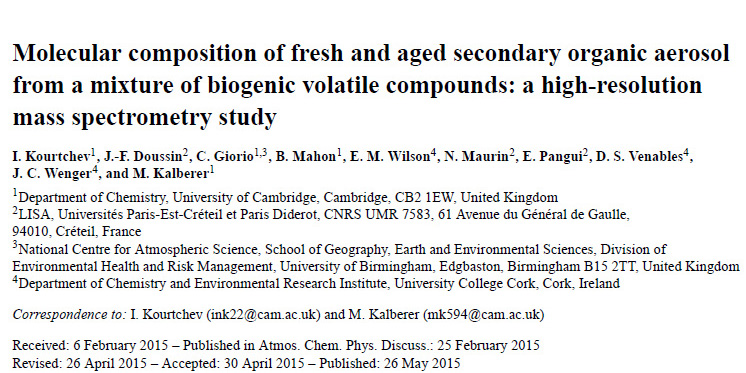In This Section
New Publication in Atmospheric Chemistry and Physics

Cambridge-Paris-CRAC collaboration.
An atricle has been published in Atmospheric Chemistry and Physics based on collaborative work between CRAC and groups in Cambridge and Paris. The publication focuses on the ageing of secondary organic aerosol from a mixture of biogenic volatile compounds and involved CRAC members Prof. John Wenger, Dr. Dean Venables and Dr. Eoin Wilson.
Abstract
Field observations over the past decade indicate that a significant fraction of organic aerosol in remote areas may contain highly oxidized molecules. Aerosol processing or further oxidation (aging) of organic aerosol has been suggested to be responsible for their formation through heterogeneous reaction with oxidants and multigenerational oxidation of vapours by OH radicals. In this study we investigated the influence of several aging processes on the molecular composition of secondary organic aerosols (SOA) using direct infusion and liquid chromatography high-resolution mass spectrometry. SOA was formed in simulation chamber experiments from ozonolysis of a mixture of four biogenic volatile organic compounds (BVOC): α-pinene, β-pinene, Δ3-carene and isoprene. The SOA was subsequently aged under three different sets of conditions: in the dark in the presence of residual ozone, with UV irradiation and OH radicals, and using UV light only. Among all studied conditions, only OH radical-initiated aging was found to influence the molecular composition of the aerosol and showed an increase in carbon oxidation state (OSC) and elemental O / C ratios of the SOA components. None of the aging processes produced an observable effect on the oligomers formed from ozonolysis of the BVOC mixture, which were found to be equally abundant in both "fresh" and "aged" SOA. Additional experiments using α-pinene as the sole precursor demonstrated that oligomers are an important group of compounds in SOA produced from both ozonolysis and OH radical-initiated oxidation processes; however, a completely different set of oligomers is formed under these two oxidation regimes. SOA from the OH-initiated oxidation of α-pinene had a significantly higher overall OSC and O / C compared to that from pure ozonolysis experiments confirming that the OH radical reaction is more likely to be responsible for the occurrence of highly oxidized species in ambient biogenic SOA.
Other Links:
- Full List of CRAC Publications
Centre for Research into Atmospheric Chemistry
Ionad Taighde Um Ceimice Atmaisféarach
Contact us
Lab B1, Kane Building, University College Cork, T12 YN60.
